What is BLACKLIGHT PRINT?
This is a magic trick printing technique that uses ink that emits full-color light when illuminated by a black light. The printed material emits light to reproduce fantastic visuals. The high color reproducibility makes it appear three-dimensional, and the vividly glowing visuals that emerge from a blank sheet of paper are a sight to behold.
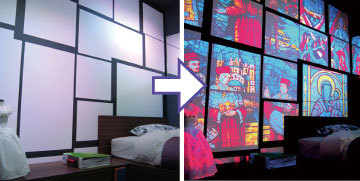
①About Triggers
The trigger for the appearance of the hidden design in blacklight printing is "UV light from a black light". The hidden design emits light by reacting to the ultraviolet rays of a black light illumination or a handy UV light.


②Technical Overview | Product Specifications
This is a printing technology using a special ink based on three types of pigments that react to wavelengths around 375 nm of ultraviolet light and self-emit red, blue, and green, respectively. The printed surface emits colorless to full-color light when exposed to UV light, and instantly returns to a non-luminescent state when the UV light is shut off.

Ink developed by our company
| Blacklight Print Product Specifications | |
| ink | Water-based ink for indoor use. |
| paper | Interior paper. *In addition to paper, fabrics are also available. |
Color Reproduction of Hidden Designs
Blacklight print is printed using blacklight ink that emits light in RGB. As with TV monitors and PC monitors, color reproduction is based on additive color mixing (RGB), so black is the base color when nothing is emitted, and the more RGB light overlaps, the closer to white the color becomes, and the most overlapped state is white. In general CMYK printing, the color reproduction is the opposite of general (CMYK) printing, as white is the state in which nothing is printed and black is the state in which the most color overlaps.
Differences in color appearance due to black light illumination
The same printed material will show different colors depending on the peak wavelength of the black light illumination. For this reason, printing is performed with color reproduction settings that match the peak wavelength of the lighting used.
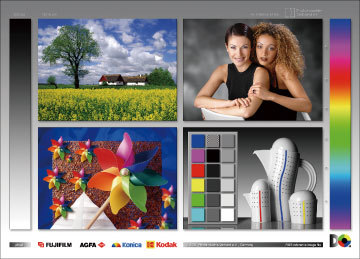
Data for printing<A>
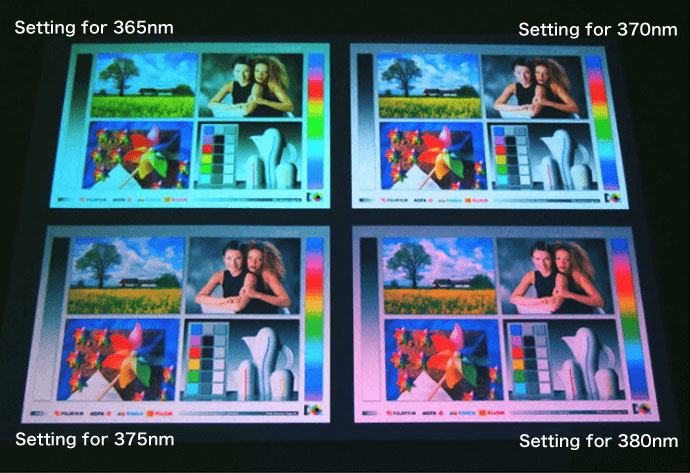
Actual printing result <B>
| Verification Method | 1. | Place the data for printing <A> on the left, right, top and bottom sides and make different settings for each. | |
| Top left: Set for 365nm | Top right: set for 370 nm | ||
| Bottom left: Set for 375 nm | Bottom right: set for 380 nm | ||
| 2. | Printed with Blacklight print. Printed result <B>. | ||
| 3. | Photographed by black light illumination with a peak wavelength of 370 nm. | ||
| Verification Results | Under 370nm illumination, the color tone is different from the original data except for the setting for 370nm. | ||
③Precautions for installation and use
Recommended Lighting
For full color reproduction, UV-LEDs with peak wavelengths of 365 to 380 nm or black light fluorescent tubes with peak wavelengths of 365 nm and 375 nm are suitable. Long-wavelength (peak wavelength around 400 nm) blacklights sold at low prices are not recommended for full-color reproduction because red is not visible. Also, they do not react to ultraviolet rays from the sun.
| Types of ultraviolet radiation | brief review | |
| UV-LED | Peak wavelength 365-380nm | Suitable for full color reproduction of hidden designs. |
| Black Light Fluorescent Tubes | Peak wavelength 365nm or 375nm | |
| Long wavelength type black light | Peak wavelength around 400nm | The red color of the hidden design is not visible. Therefore, full color reproduction of the hidden design is not possible. |
| ultraviolet rays of the sun | Hidden designs do not emit light. | |
Visibility indoors and outdoors
The brightness of the installation environment affects the visibility of the blacklight print's hidden design. The darker the environment, the easier it is to see even under low UV intensity lighting.
| Installation environment | Visibility of hidden design |
| bright | hard to see |
| dark | easily visible |
Durability when continuously irradiated with ultraviolet light
Durability under continuous black light illumination or when installed outdoors.
In indoor exhibits using UV flashlights, the durability will be much higher than the table below because the environment is not one of continuous irradiation.
| Usage environment | Days to fade |
| If black light illumination is applied continuously in an indoor installation | Approx. 2 to 3 years |
| *When irradiated with UV light equivalent to a 40w fluorescent tube for 8 hours per day at an irradiation distance of 180cm | |
| If installed outdoors, where it is subject to the ultraviolet rays of the sun's rays | Approx. 1 day |
| *If continuously exposed to ultraviolet rays at about 12:00 noon in midsummer, luminous brightness is reduced by half in about 5 hours. | |
| Definitions for fading and number of days | The number of days that a color balance is lost and full color reproduction becomes impossible. |
| The number of days may be longer than indicated depending on the use of a single color or the colors used. | |
| Difference in fading speed by color | Each color has a different fading speed.The luminous intensity decreases in the order of red, blue, and green. |
Verification of fading under continuous exposure to ultraviolet light
The following verification is the number of fading days when continuous irradiation is assumed. If it is assumed as a staging for interior materials, the fading days can be extended by avoiding continuous irradiation or extending the irradiation distance.
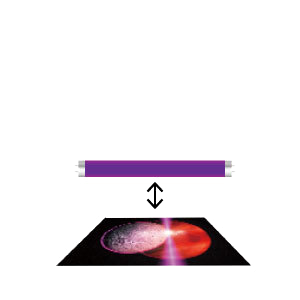
| Distance to light source | 10cm~under 30cm |
| Continuous irradiation time per day | 8 hours |
| Basic fading days | About 15 days |
| In environments where lighting is close, such as electric signage, it is limited to spot events. | |
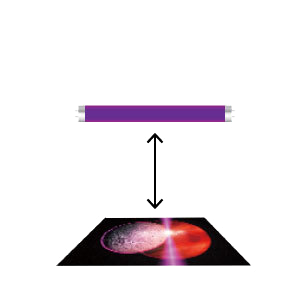
| Distance to light source | 30cm~under 80cm |
| Continuous irradiation time per day | 8 hours |
| Basic fading days | About 90 to 180 days |
| A distance of 30 cm or more between the printed matter and the lighting will result in a slow fading speed. | |
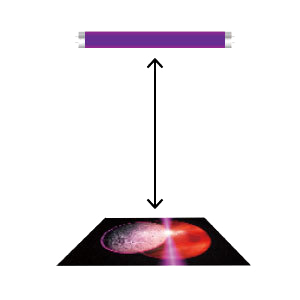
| Distance to light source | Over 80cm |
| Continuous irradiation time per day | 8 hours |
| Basic fading days | About 180 to 365 days |
| This is a guideline for use in wall decoration, etc. | |
| Verification environment | |||
| Paper used for verification | "Shiraoi Joshitsushi"inkjet paper | ||
| Lighting used for verification | 375nm LED Black Light Fluorescent Lamp | UV intensity | 66μW/cm² |
| emission spectrum | 375nm | ||
| *Verification for October 2010 | |||
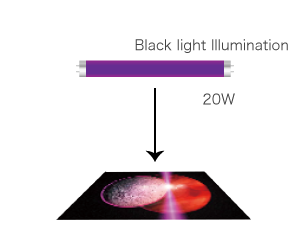
Effects can be achieved at lower UV intensities in dark environments, extending the number of days until fading.
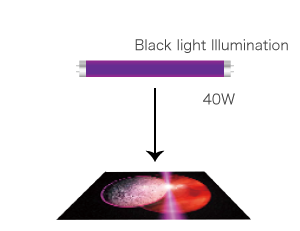
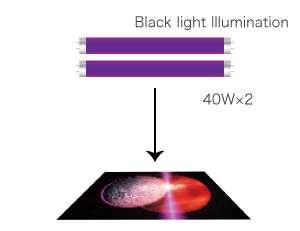
In bright environments, UV intensity must be strong to be effective, which shortens fading days.
